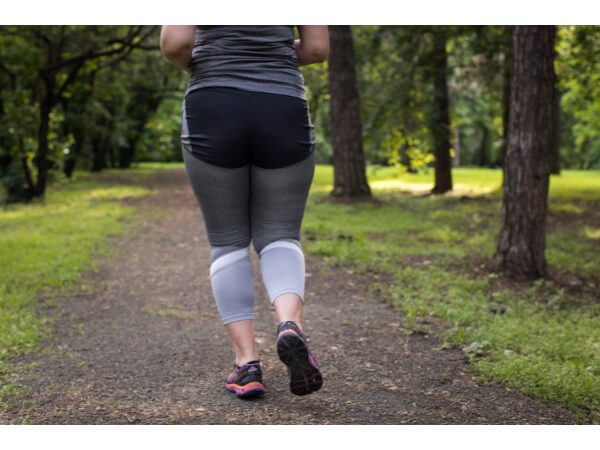Are you ready to say bye to those extra pounds for good? Running could be your ticket to a leaner, healthier you. But is hitting the pavement really the answer to achieving your weight loss goals? In this article, we’ll dive into how running can support your weight loss journey. We’ll cover everything from calorie burn to workout strategies and those all-important running tips. Get ready to lace up your sneakers and transform your body – one stride at a time.
In This Article:
Does running help with weight loss?
The answer is a resounding yes! To understand why running is so effective for weight loss, let’s dive into the science of calorie expenditure. Weight loss fundamentally depends on creating a calorie deficit – burning more calories than you consume. Running is a fantastic tool in this process because it’s a high-impact activity that engages multiple muscle groups, resulting in significant calorie burn.

How many calories are burned while running?
There’s no single universal answer as calorie burn during running is influenced by several factors:
- Weight: People with a higher body weight tend to burn more calories than those with a lower body weight when running at identical pace and duration.
- Pace: Faster running increases your heart rate and the intensity of muscle work, leading to a higher calorie burn.
- Terrain: Challenging terrain, like hills or trails, ramps up your energy expenditure compared to running on flat surfaces.
That said, a general guideline is that the average person burns approximately 100 calories per mile. For example, a 160-pound person running at a moderate pace (6 mph) for one hour could expect to burn around 600 calories.
How much do you need to run to lose weight?
To lose one pound of fat, you need to create a calorie deficit of approximately 3,500 calories. This means you could achieve your goals with different approaches:
- Consistent running: Opting for 3-5 moderate-paced runs per week can lead to a steady calorie deficit and gradual weight loss.
- Intense workouts: Incorporating 2-3 interval training sessions or challenging hill runs can boost calorie burn and potentially speed up your results.

Which running workouts are best for weight loss?
Variety is key. Here are a few effective workouts to promote weight loss:
- Steady-state runs: Longer runs at a comfortable pace focus on building endurance and burning a consistent amount of calories.
- Interval training (HIIT): Short bursts of high-intensity running followed by rest periods maximize calorie burn in less time.
- Hill runs: Tackling inclines challenges your muscles, increases energy expenditure, and builds strength.
- Tempo runs: Sustained runs at a slightly faster-than-comfortable pace, improving your body’s ability to burn fat efficiently.
Important Note: Sustainable weight loss often takes time. Finding a running routine you enjoy, paired with a balanced diet, will set you up for long-term success and better overall health.
Beyond Calories: Can Running Melt Away Stubborn Fat?
We know running burns calories, but does it directly target body fat? The answer is yes. When your body needs energy during a run, it taps into stored fuels like carbohydrates and fat. Here’s how it works:
- Early stages: At the start of a run, your body primarily uses carbohydrates for quick energy.
- Fat-burning zone: As you run longer (especially at a moderate pace), your body shifts to utilizing fat stores for fuel.
- Intensity matters: Higher-intensity runs boost metabolism and can lead to continued fat burning even after your workout ends, due to EPOC (excess post-exercise oxygen consumption).
This isn’t just speculation – it’s backed by science. A study published in the Journal of Obesity found that regular aerobic exercise, including running, led to significant reductions in belly fat, even without drastic dietary changes (Irving et al., 2008). Additionally, research in Medicine & Science in Sports & Exercise demonstrated that combining diet and running resulted in greater fat loss, particularly abdominal fat, compared to diet alone (Donnelly et al., 2013).

How to Maximize the Running for Weight Loss
Running offers a fantastic path to weight loss, but maximizing results takes some strategy. Here’s how to boost your calorie burn and make every stride count:
- Mix it up: Don’t fall into a rut of running at the same pace every day. Incorporate a variety of running workouts to challenge your body and prevent plateaus:
- Long, slow runs: Build endurance and increase time spent in the fat-burning zone.
- Intervals: Alternate high-intensity bursts with rest periods for a major metabolic boost.
- Hill repeats: Challenge your muscles and cardiovascular system to burn a ton of calories.
- Fuel your runs: What you eat before a run can impact your energy levels and performance. Choose easily digestible carbs like a banana or a piece of whole-grain toast for sustained energy.
- Don’t skip your strength training: Building muscle mass increases your metabolism, allowing you to burn more calories even at rest. Aim for 2-3 strength training sessions per week.
- Stay hydrated: Proper hydration is essential for optimal performance and recovery. Drink plenty of water throughout the day and aim to consume fluids during longer runs.
- Listen to your body: Rest days are essential. They allow your muscles to recover and rebuild, reducing your risk of injury and supporting your long-term progress.
Important Note: Combining running with a healthy, balanced diet is crucial for sustainable results. Consult a registered dietician for a personalized eating plan to support your weight loss goals.

Running on Empty? Why Diet is Your Weight Loss Sidekick
You can run all you want, but if your diet isn’t in check, you might not see the results you crave. Here’s why a healthy diet is crucial when running for weight loss:
- Fuel for the fire: Think of food as high-performance fuel for your runs. A balanced diet provides the energy and nutrients needed to maximize performance and recovery.
- Outrun a bad diet? Not so fast: While running burns calories, you can easily negate those efforts with unhealthy eating habits.
- Muscle building and repair: Protein is your body’s building block. Adequate intake supports muscle repair and growth, particularly important for runners.
- Satisfaction = Success: A diet rich in whole foods, fiber, and a healthy amount of fats helps you feel satisfied, reducing the risk of overindulging or sabotaging your weight loss.
Key Points to Consider:
- Don’t under-eat: Restricting calories too much can backfire, causing energy crashes and hindering your runs.
- Quality counts: Focus on whole foods like fruits, vegetables, lean proteins, and healthy grains.
- Timing matters: Properly fueling before and after your runs optimizes energy and muscle recovery.
Think of running and a healthy diet as a dynamic duo – working together to help you reach your weight loss goals!

Don’t Trip Up Your Weight Loss Journey: Mistakes to Avoid
Running is a powerful weight-loss tool, but a few common mistakes can sabotage your progress. Here’s how to sidestep these pitfalls:
- Neglecting nutrition: Remember, you can’t outrun a bad diet. Prioritize fueling your body with quality food for optimal results.
- Overestimating calorie burn: While running burns significant calories, it’s easy to overestimate how much. Avoid indulging in treats thinking you’ve earned them without being mindful of your calorie intake.
- Running too hard, too fast: Pushing yourself to the limit every run is a recipe for burnout and injury. Include rest days and easier runs for sustainable training.
- Skipping strength training: Building muscle helps you burn more calories at rest. Supplement your running with resistance training for maximum fat-burning potential.
- Forgetting to hydrate: Dehydration hinders performance and recovery. Aim to stay hydrated throughout the day, especially before, during, and after your runs.
- Ignoring your body: Pain is a signal, not a medal. Pushing through injuries can significantly sideline your progress. Listen to your body and take rest when needed.
Run for the Wins: Beyond Weight Loss
While running is a fantastic weight-loss tool, the perks extend far beyond shedding pounds. Here’s why lacing up those sneakers benefits your whole life:
- Healthy heart: Running strengthens your cardiovascular health, reducing your risk of heart disease, stroke, and high blood pressure.
- Mood boost: Running can support your mental health. It reduces stress, helps manage anxiety, and can even boost self-esteem.
- A stronger you: Running builds stronger bones, increases muscle mass, and improves your overall fitness.
- Sleep soundly: Regular exercise, like running, promotes better sleep, helping you feel more rested and energized.
- Immunity support: Moderate-intensity exercise strengthens your immune system, potentially making you less susceptible to getting sick.
Bottom Line: Running isn’t just about transforming your body, it transforms your life. Each stride brings you closer to a healthier, happier, and more resilient you.

Lace Up and Conquer: Your Weight Loss Journey Starts Here
Ready to unleash your inner runner and kickstart your weight loss transformation? Here’s how to hit the ground running:
- Gear up: Invest in a good pair of running shoes for comfort and injury prevention.
- Set realistic goals: Start small with achievable distances and speeds. Consistency is more important than intensity in the beginning.
- Warm-up and cool-down: A few minutes of dynamic stretching before your run and static stretches afterward helps prevent muscle soreness and injuries.
- Find your rhythm: Don’t worry about being fast. Choose a pace that allows you to hold a conversation.
- Listen to your body: If you’re feeling pain, stop and rest. It’s better to take a break than risk an injury.
Beginner’s Running Plan for Weight Loss
Important Considerations:
- Listen to your body: Adjust the pace and duration of your runs according to your fitness level. If you need more rest, repeat the week’s plan.
- Cross-training: On rest days, incorporate activities like swimming, cycling, or strength training.
- Nutrition: Combine your running plan with a healthy, balanced diet.
The Plan
- Weeks 1-2:
- 3 runs per week
- Alternate 5 mins brisk walking with 1 min jogging for a total of 20-30 minutes.
- Weeks 3-4:
- 3 runs per week
- Alternate 3 mins brisk walking with 2 mins jogging for a total of 25-35 minutes.
- Weeks 5-6:
- 3-4 runs per week
- Alternate 2 mins brisk walking with 3 mins jogging for a total of 30-40 minutes.
- Weeks 7-8:
- 3-4 runs per week.
- Start including one longer, continuous run at a comfortable pace (20-30 minutes).
- Other days: Mix shorter jogs (20-25 minutes) with intervals (ex: 5 min warm-up, 5 x (1 min hard running, 1 min recovery), 5 min cooldown)
- Weeks 9 and beyond:
- Continue with 3-4 runs per week
- Gradually increase the duration of your long run and consider adding an additional interval workout.
Progression: Over time, aim to reduce the walk breaks gradually until you can jog continuously. Listen to your body and adjust the plan accordingly.
Additional Tips:
- Warm-up: Before each run, include 5 minutes of dynamic stretching, like arm circles and leg swings.
- Cool-down: Finish with 5 minutes of static stretches, such as holding hamstring or calf stretches.
- Strength training: Incorporate strength training 2-3 times a week, focusing on bodyweight exercises or using light weights.
Takeaways: Your Roadmap to Reaching Your Goals
Running is a powerful tool for weight loss and overall health. Here’s a recap of the most important points to remember as you start your journey:
- Calories matter: Running burns a significant amount of calories, helping you create the calorie deficit needed for weight loss.
- Fat-burning mode: Your body uses fat stores for fuel during your runs, especially as they get longer.
- Variety is key: Different running workouts (interval training, hills, steady-state) challenge your body, maximizing your results.
- Fuel up wisely: A balanced diet gives you the energy to perform at your best and supports your weight loss efforts.
- Avoid common pitfalls: Be mindful of overeating, overtraining, and neglecting strength training or hydration.
- Beyond the scale: Enjoy the fantastic health benefits of running – stronger heart, better mood, sounder sleep, and overall increased resilience.
- Start small, dream big: A gradual approach to running increases your chance of success. Get started with our sample plan, listen to your body, and celebrate every milestone!
The Transformation Starts Now
You have all the knowledge you need to transform your body and health through running. Lace up, set achievable goals, and embrace the process. Remember, each stride brings you closer to a fitter, healthier, and happier you!
Frequently Asked Questions
Can I lose weight by running 30 minutes a day?
Yes, running 30 minutes a day can be an effective way to contribute to weight loss. Combined with a healthy diet, it helps create a calorie deficit. The amount of weight you lose depends on factors like your diet, pace, and overall fitness level.
Do you lose belly fat by running?
Running can help reduce belly fat. When you run, your body taps into stored fat, including belly fat, for energy. Combining running with a healthy diet amplifies fat loss throughout your body.
Is 1 hour jogging enough to lose weight?
One hour of jogging can burn a significant number of calories, making it a great way to support weight loss. Remember that diet plays a crucial role – be sure to focus on healthy eating alongside your running routine.
Is running 3 km a day enough to lose weight?
Running 3km a day can definitely contribute to weight loss. The exact amount of weight loss depends on your diet, running intensity, and other individual factors.
Will I lose fat if I jog everyday?
Jogging every day helps burn calories and potentially tap into fat stores for fuel. Combining jogging with a balanced diet optimizes fat loss. Remember, rest days are important to allow your body to recover and prevent injuries.
References
- Williams, P.T., 2013. Greater weight loss from running than walking during 6.2-yr prospective follow-up. Medicine and science in sports and exercise, 45(4), p.706.
- Burfoot, A. ed., 2009. Runner’s World Complete Book of Running: Everything You Need to Run for Weight Loss, Fitness, and Competition. Rodale.
- Knechtle, B., Knechtle, P., Wirth, A., Alexander Rüst, C. and Rosemann, T., 2012. A faster running speed is associated with a greater body weight loss in 100-km ultra-marathoners. Journal of sports sciences, 30(11), pp.1131-1140.
- Koplan, J.P., Powell, K.E., Sikes, R.K., Shirley, R.W. and Campbell, C.C., 1982. An epidemiologic study of the benefits and risks of running. Jama, 248(23), pp.3118-3121.
- Vincent, H.K. and Vincent, K.R., 2013. Considerations for initiating and progressing running programs in obese individuals. PM&R, 5(6), pp.513-519.
- Hazell, T.J., Hamilton, C.D., Olver, T.D. and Lemon, P.W., 2014. Running sprint interval training induces fat loss in women. Applied Physiology, Nutrition, and Metabolism, 39(8), pp.944-950.














